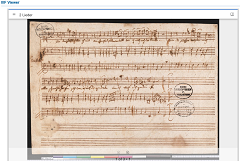New Features in the RISM Catalog
Tuesday, February 8, 2022

RISM and the Bavarian State Library (BSB, Bayerische Staatsbibliothek) announce a major upgrade of the RISM Catalog of Musical Sources at https://opac.rism.info/.
One of the first things that users might notice is the display of IIIF objects. The International Image Interoperability Framework (IIIF) is a technical standard that allows images to be displayed directly on other websites without needing to upload anything. This means that hundreds of digitized music manuscripts and printed editions can be viewed on the RISM catalog entry’s page without clicking on an external link or leaving the catalog.
For example, an autograph manuscript by Mozart of two lieder (RISM ID no. 659100006) includes both a button linking to the Mozarteum’s digital library (“View Online”) as well as a button labeled “IIIF Display.” This IIIF display can be seen if you click on the button, or simply continue scrolling down. Beneath the source description is the manuscript itself. Without leaving the RISM catalog, you can page through the manuscript and zoom in and out. The IIIF technology allows you to see the Mozarteum’s scan directly through the RISM catalog. You can even see multiple IIIF objects at once, such as a manuscript and its watermarks from the BSB (RISM ID no. 456054384). The Mirador viewer is employed to enable the IIIF display.
Another notable new feature is the search for new or updated records. In the results list, the last filter on the left displays the records that have been created or updated in the last 1, 3, 6, or 12 months. Furthermore, each record contains, in the bottom right corner, the date that it was last updated.
We have also implemented an “open all/close all” button in the list of holding institutions for printed editions. This allows you to expand all holdings information at once, which is particularly useful if you landed on a record through search for a particular previous owner, for example. Simply click “open all” and use the “search on page” function in your browser to look for the person. In a record like this one with dozens of holdings (RISM ID no. 990053593) you’ll be thankful for this button.
We have also implemented a couple new cataloging practices that our RISM contributors can elect to employ in order to enrich the information you view in RISM. One of these is a fingerprint identifier for printed music, which is an alphanumeric code that is derived from looking at a certain combination of pages in a historical printed book. If you can determine that fingerprint for a 1695 book of odes is n?n, n;t, v.at BeDr C 1695R, for example (RISM ID no. 990064189), and then if you find another copy with the same fingerprint, you can be reasonably certain that your copies were printed from the same settings of type from the same print run, and are not part of a different state or edition. These are important details for people interested in book history and looking at the development of a certain book in print.
The field Related source is also available to indicate whether a RISM record is somehow connected to another source in RISM. For example, we can see that this manuscript of George Frederick Root’s song “Daniel” held by the Moravian Music Foundation (RISM ID no. 243182) was copied from the printed collection The Sabbath Bell (RISM ID no. 1001125501). Other related sources can point to additional performance parts, arrangements, concordant sources, and inserts.
Finally, some RISM contributors are describing composite volumes (also known as binders’ volumes or bound-withs) held by their institutions. These are unique volumes, frequently brought together by an individual to collect music of similar instrumentations. This composite volume of songs for voice and piano at Kloster Einsiedeln (RISM ID no. 1001103380) consists of 15 separate music editions plus an autograph manuscript, all bound together. If you land on a record for an item that is part of a composite volume, a link (if added by our catalogers) will take you from the manuscript or printed edition to the composite volume, and back again to the individual source. Such volumes are invaluable for the study of musical taste, collecting habits, and repertoire.
Thanks to the efforts of the BSB, the coming months will see further developments of the RISM catalog, including improvements to the display of the institutions and secondary literature.
Share Tweet EmailCatégorie: Catalogue RISM en ligne

